Here’s a quick headline from Haaretz, last night. It reads:
Israelis who were supposed to be able to die at a ripe old age in their own beds are rotting away in a dank tunnel, but he has time.
It’s a reference to Netanyahu, of course, and growing national frustration with the government’s inability to find some way to get the remaining hostages home. Haaretz, obviously, has never been a huge fan of Bibi—but this headline could have appeared in almost any Israeli newspaper this week.
For much of the past ten days or so, Israelis have waited anxiously to hear whether Hamas would accept a proposal by Israel that would have led to the return of all of the hostages, in various stages, in exchange for a cease-fire of some sort—the exact details were not clear.
As of today, not only is there no deal, but both the Israeli and American governments are warning that we should not get our hopes up, that there is no deal about to be hatched. This, understandably, was yet another agonizing disappointment for the families of the hostages, who worry that with each passing day, more will die and others will become very ill.
As the above video makes clear, the treatment of the hostages has, in some cases, been horrifying. The video about Elma Avraham came out around the 100th day of captivity on Israeli TV about three weeks ago. What she and her children say about the urgency of getting the rest of the hostages out has only become more urgent.
Israelis are quite rightly consumed by the hostage issue. Yesterday, on the way to Tel Aviv, I stopped at a red light and saw the sign below right outside the window of my car.
It’s the now ubiquitous array of hostages still being held, with the Hebrew words that say “No stopping until they all come home.” On the sign, though, someone pasted some white paper and wrote בכוח - בלי מו”מ, which means, “by force, no negotiations.”
Obviously, if Israel could have brought the hostages out by force, it would have. So they’re likely to get home only through negotiations—but it’s clear that the frustration is wearing on an already weary society.
When I parked in Tel Aviv, I walked through the plaza outside the Opera House and Museum on my way to my meeting. Since the very first days of the war, that plaza has been turned into Kikar Ha-Chatufim, Hostage Square. It was a rainy day in Tel Aviv, so there weren’t a ton of people there, but it’s still beyond painful.
There’s a gigantic screen counting the ticking seconds, as you can see in this brief video:
And there are displays throughout, such as this table set for the hostages, waiting for them to return. In the background, as you can see on the right below, is the iconic tower of the Kiriyah, Israel’s IDF headquarters, our Pentagon. It’s smack in the middle of Tel Aviv (though there has been much discussion of moving it to the Negev).
I don’t know how many people who see the setup find it as ironic as I did. After all, those people are hostages because the people who work in the Kiriyah (ie, all the top brass) utterly failed to do their jobs.

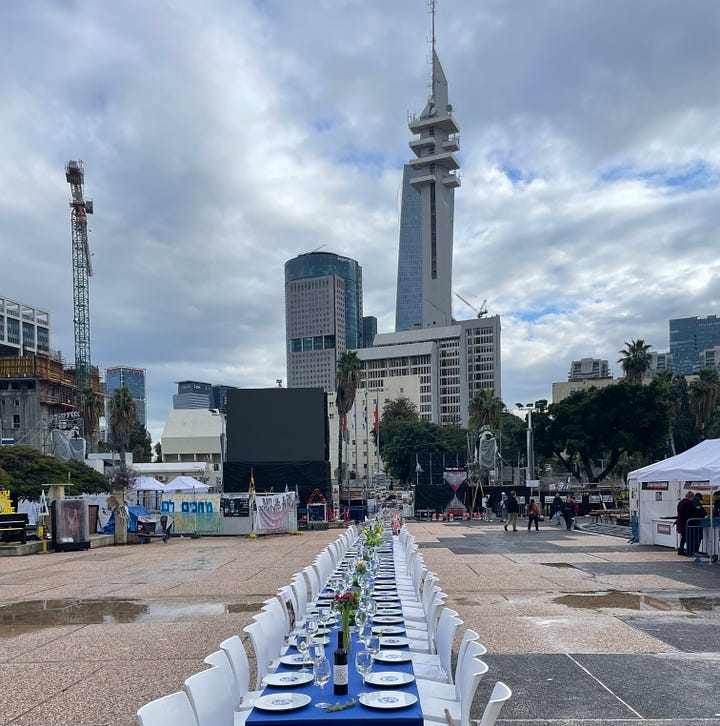
There are signs everywhere, each put up by a different organization. From left to right below:
“We are all hostages, until they all return.”
“There’s no such thing as victory without the hostages [returned]” and underneath, the Mahanot HaOlim Youth Movement stands with the families of the hostages
“The paratroopers from October 1973 embrace the families and hostages of October 2023, and send them strength from the depths of our hearts” and underneath, “the organization for the preservation of the memory of Paratroopers on the Round Mountain.”
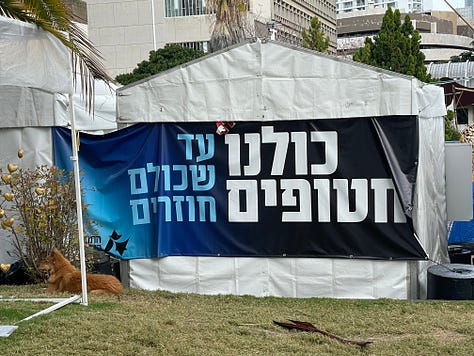


People each seek some way of “interacting” with people they cannot interact with. In one of the main tents, a woman was drawing the faces of the hostages and hanging them, working from photos she had on her phone. The families of the hostages built a fake “tunnel” with the same dimensions as the Hamas tunnels, so visitors could get a sense of the claustrophobia (and worse). The walls turned into places where people used markers of all different colors to send messages of encouragement to the families.
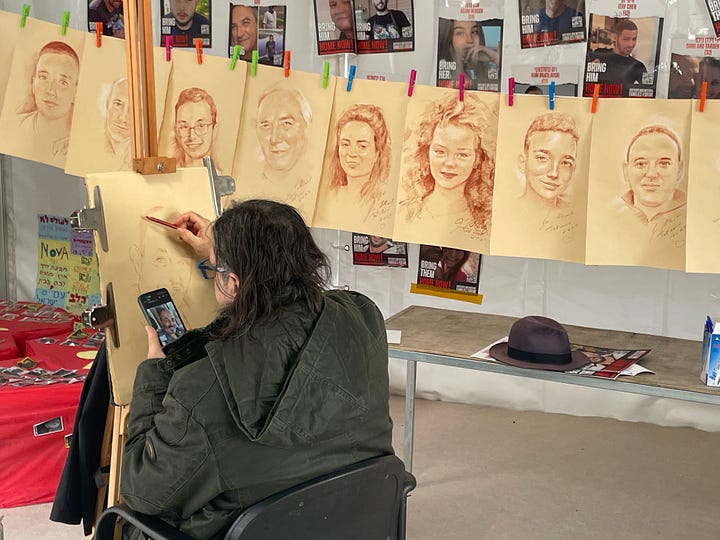
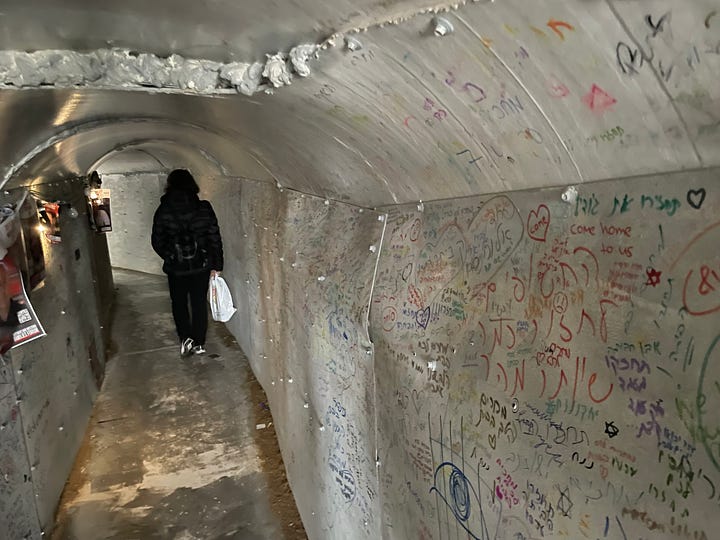
In what to me was the height of irony, in the photo below you see that same sign as the one in the very top photo above, this time not at a traffic light, but at the same plaza. And behind it, a more permanent sign about Israel’s devotion to the principles of the Declaration of Independence. There, in one shot, a reminder of the first massive calamity of 2023, which now, in light of the horrific calamity of October, can at times even seem quaint.
If you haven’t yet watched the video above about Elma Avraham, do. That’s a formerly completely healthy woman after fifty days of hospitalization, once she was released from captivity after about fifty days.
For those remaining, it’s been 125 days.
One shudders to imagine. …








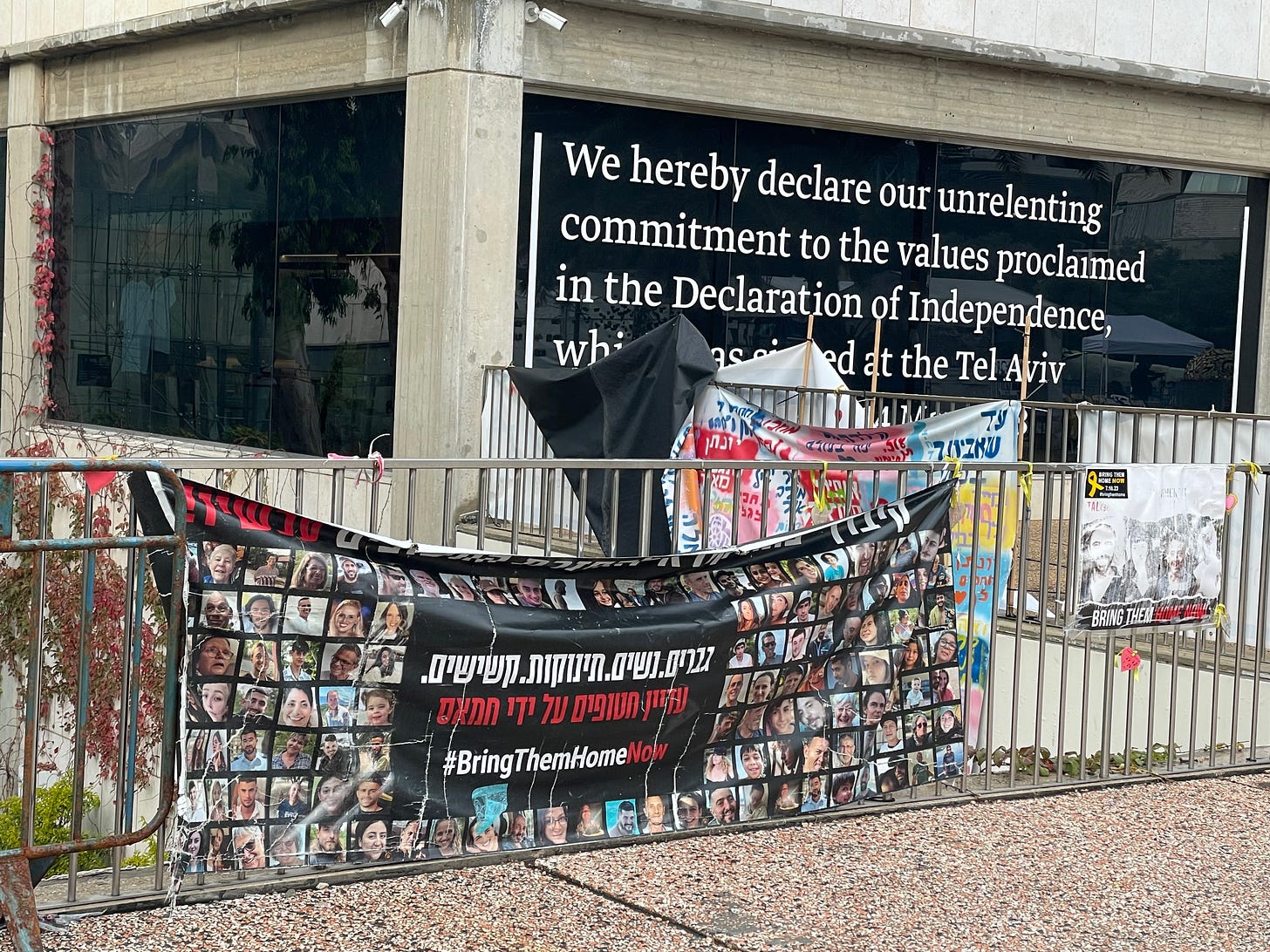














What do you want from Netanyahu? To negotiate with Hamas for the hostages' release means a permanent ceasefire, allowing Hamas to rebuild itself and repeat Oct. 7 in a couple years, plus the release of a thousand terrorist murderers. Would you really agree to that? Hamas will agree to nothing less. THERE IS NO ONE TO NEGOTIATE WITH!
It’s fair to blame Netanyahu for the situation that led to disaster on October 7th. It’s completely unfair to blame him for the continued captivity of the hostages. He’s playing the hand dealt to him by the Americans. There was a hostage deal early on when no food or water was going into Gaza. Now, Hamas has all the supplies it needs to hunker down and wait for pressure on the Israeli government - both external and internal - to capitulate.
life... Am israel Chai
Heart-wrenching! My love and support to Elma and all the hostages freed or still in captivity. BRING THEM HOME!
Love to Elma.
With each passing second, minute, hour, day and week, the prospects seem dimmer and dimmer. Prayers and love for all in captivity. #bringthemallhomenow עם ישראל חי
Heartbreaking - but necessary for all to know and see. Thank you for posting.
Am YISRAEL Chai!🇮🇱
Todah Daniel for the excellent reporting; so utterly heartbreaking and mind-numbing. Yesterday's link to Elliot Abram's piece in Tablet was resonant. Re: Palestinians, if one takes these options off the table--kill them, displace them, occupy them, apartheid them, annex them--AND self-determination would only lead to the Gaza-tion of Judea and Samaria, what does that leave?
I will ask one question that everyone should answer, at least for themselves.
What is Netanyahu not doing that another prime minister would do in his place?
And what did Netanyahu do that someone else in his place wouldn’t do?
Sorry, these are two questions.
See all those 'innocent' Gaza civilians ?
They need sent to their Allah.